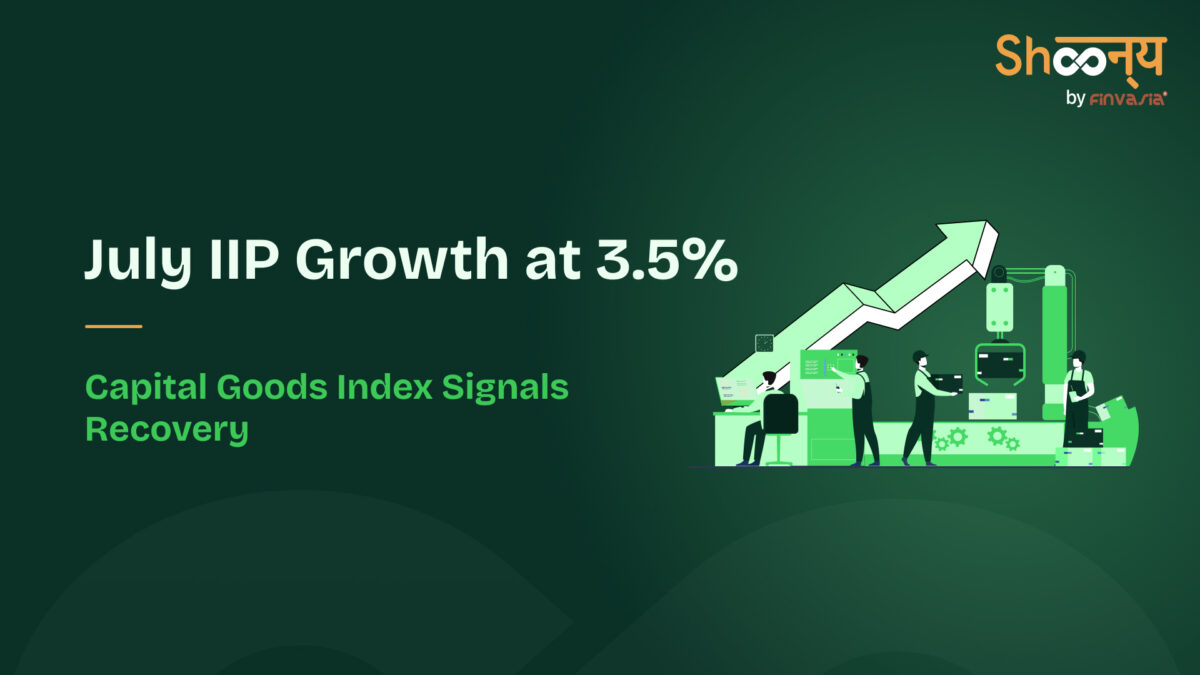Index of Industrial Production Rises 3.5% in July, Manufacturing Leads

India’s industrial output showed some signs of recovery in July 2025, with the Index of Industrial Production (IIP) rising 3.5%. This marks a four-month high, compared to just 1.5% in June.
The improvement was primarily led by manufacturing growth, which hit a six-month high of 5.4%. Steel and cement also recorded double-digit gains, supported by government capex. On the other hand, electricity and mining remained weak, keeping overall industrial activity subdued.
While the latest India IIP data signals some revival in investment and consumer demand, challenges remain. US tariffs on Indian goods and uneven urban consumption could weigh on momentum in the months ahead.
Key Highlights of July IIP Growth
- The Index of Industrial Production rose 3.5% in July, up from 1.5% in June, marking a four-month high.
- Manufacturing grew 5.4%, the strongest in 6 months.
- Electricity sector growth at 0.6%, after contracting in June.
- Mining declined by 7.2%, primarily due to the impact of the monsoon and weaker demand.
- Strong performers, with steel up 12.8% and cement up 11.7%.
- Consumer Durables rose to a seven-month high of 7.7%, showing signs of demand revival.
- Construction Goods jumped 11.9%, the first double-digit rise since Dec 2023, boosted by a capex push.
- Capital goods index improved to 5%, reflecting early signs of investment recovery.
- Growth slowed to 2% in July, with four industries slipping into contraction.
Detailed Impact Analysis
The IIP growth at 3.5% signals resilience, but markets may view it as a mixed outcome. Substantial gains in manufacturing, steel, and construction are a positive development. However, weak performance in mining and electricity may keep investor sentiment cautious.
- Manufacturing: With a 5.4% growth rate, it has become the key driver of growth. Auto, steel, and cement companies stand to benefit in the near term.
- Mining & Electricity: Weakness here could hurt companies dependent on raw material extraction and power demand.
- Construction & Infrastructure: Strong growth in construction goods (11.9%) reflects government capital expenditure, boosting the cement, steel, and allied industries.
- Consumer Goods: Consumer durables rose 7.7%, a positive sign for companies in appliances, electronics, and auto segments. However, non-durables remain muted, highlighting uneven demand.
- Capital Goods Index: The improvement to 5% indicates an early revival in private investments, which is a good sign for machinery and equipment makers.
What It Means for Shoonya Traders & Investors
For short-term traders
- Expect rotation into steel, cement, construction, and capital goods on the basis of momentum. So, be cautious in mining and power until print improvements are seen.
- Track intraday volatility around data drops (Core Industries, PMI, CPI/WPI). Maintain tight stop-losses and manage position size.
- For F&O, watch OI/volume build-ups in capital goods and infrastructure names; rising IV near data releases can widen spreads.
For positional investors
- Tilt toward domestic-demand stories (infra, building materials, select manufacturing) while keeping exposure to export-heavy names.
- Look for companies showing order-book growth (capital goods), utilisation upticks (cement/steel), and working-capital discipline.
- You should keep portfolios diversified. It is important to avoid overconcentration in any one weak sector (such as mining/power).
Conclusion
India’s July IIP growth of 3.5% offers a mixed picture. On the one hand, manufacturing, steel, cement, and construction goods show strong momentum, indicating resilience from government capital expenditure. On the other hand, weak mining, low electricity growth, and uneven consumption suggest that the recovery remains patchy. The coming months will reveal whether this recovery can expand across sectors or remain concentrated in a few areas.
Source: MoneyControl
Disclaimer: Investments in the securities market are subject to market risks; read all the related documents carefully before investing.








